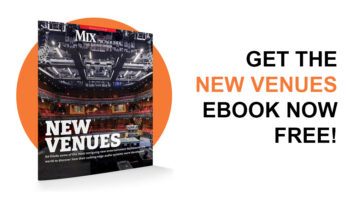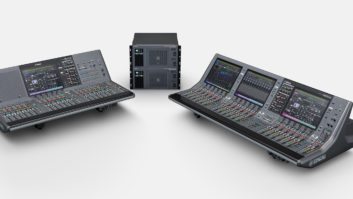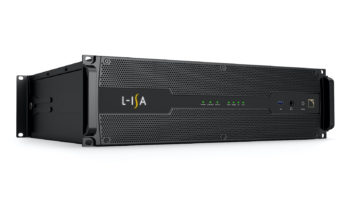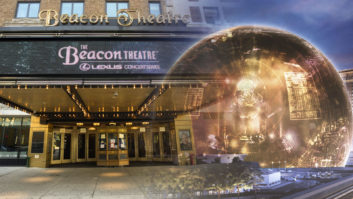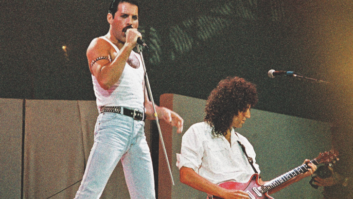
New York, NY—“In 1977, 1978, they said a punk rock band would never headline Madison Square Garden,” bellowed Glenn Danzig, singer of The Original Misfits, early on in the band’s set inside the world’s most famous arena. “Well, we’re here now, and we sold the mother—— out!”
After the band broke up in 1983—an occasion followed by several legal skirmishes—most fans (including your humble narrator) thought that any chances of the Misfits’ founding members—singer Glenn Danzig and bassist Jerry Only—sharing a stage again were long gone. Fast-forward to 2016 and Danzig and Only set aside their differences, reuniting with guitarist Doyle Wolfgang von Frankenstein for headlining shows at the 2016 Riot Fest with drummer Dave Lombardo (Slayer, Suicidal Tendencies) and second guitarist Acey Slade (Dope, Murderdolls, Joan Jett & the Blackhearts) under the name The Original Misfits. This set off a series of sold-out live shows across the U.S. that would lead the band back home to the site of its punk-rock origins—New York City—where Pro Sound News caught up with the production.

“They had a crew that they were working with earlier in their run and they wanted something different,” states Jeremy Dixon, CEO of Lenexa, KS-based Digital Sound Systems, Inc (DSS). “We started working with the band’s lighting designer, Jon Eddy, who recommended us. Jon and our lighting department manager had worked together before on the Deftones and Marilyn Manson tour. They reached out for some lighting and design, so we did all the CAD and they asked if we were interested in bidding it. We ended up doing lights and video for the Chicago show. After we did that show, they came back and asked If we’d be interested in the audio gig as well. Our first show handling their audio, video and lighting was the California Bank Stadium show, and we’ve been working with them ever since.”
Live Sound Showcase: Godsmack Tour Serves Up ‘Legends’ Live
For dates with The Original Misfits, Dixon and DSS have been using an L-Acoustics line array system to supply the sound, centered around 16 K1 cabinets used for each main hang and four K2 cabinets flown for nearfields. A full two-dozen subs run across the front to cover the low end. Outfields are comprised of 16 K2 cabinets per side, and the whole system is powered by a battery of L-Acoustics LA8 amplifiers.
“The key is trying to be consistent,” notes Dixon. “The PA is pretty straight forward. We keep the consoles custom-racked and packaged up, so it’s quick for us to get them prepped for a show that may pop up with these guys. On the September run, we went from sheds to a regular 10-12,000-seat arena, to 25,000-seat arenas, so we have to be able to scale. We put extra boxes on the truck and make sure we’re covered. That saves us from re-inventing the wheel every time.”

Front of house engineer Boris Bouma, who has worked with a long list of artists including Danzig, Black Veil Brides, Black Label Society and Suicidal Tendencies, stepped into the gig at the same time as DSS and hit the ground running. “Thing have been great,” he states. “I started working with them five shows into their run, so they had a few shows before. Half the guys are on in-ears, so we didn’t want to make too many drastic changes.”
Bouma’s FOH console of choice is the Avid Venue Profile: “I love the Avid platform; I’ve been using it for a long time,” he states. “I’ve tried the S6L a couple of times and I like it, but I haven’t been able to spend enough time on it to take it out with the Misfits because we don’t do a lot of production rehearsals. It’s usually just a glorified band rehearsal; there’s usually no soundstage. I was just in New York at SIR for one day and I used the Profile with a whole bunch of on-board Waves and Eventide plug-ins.”
Having worked with Danzig and his solo band in the past, Bouma brought some of the techniques that he used on the dynamic vocalist and applied them to The Original Misfits. “I used to work for Zakk Wylde, and he used to carry actual Eventide H3000 units with him for his monitors,” he explains. “They’re not really tour-proof—they breakdown, they tend to overheat a lot and at one point, I had to put fans on them. Eventually, I bought the [H3000 emulation] plug-ins, copied the settings from the physical units and they sounded great. When I started working for Danzig about six years ago, I tried it out with Glenn’s vocals and it worked really well.
“If you listen to the old Danzig records, it’s pretty dry,” he points out. “They’re not all reverbed and delayed out; it’s very analog, cool-sounding stuff, especially the Rick Rubin-produced ones. Well, it’s the same with the Misfits—it’s not supposed to be a very polished, delayed mix. As they say, a good delay you have to feel and not hear, so the Eventide plug-in, like a good delay, works great. You can barely tell it’s there—but I can hear it. It’s a return, it’s not inserted and I always mute it when he’s talking. I like to have his vocals pretty loud and I like to leave him on top of the mix.”
Shure Beta SM58s are Bouma’s mic of choice. “All of them are using 58s,” he notes. “They were already using them when I started and the 58s work just fine. Glenn also has a very specific mic technique where he doesn’t necessarily sing into the microphone—he doesn’t cup it, but he holds it away—so I don’t think we need anything too fancy.”
Dave Lombardo, the powerhouse behind the kit for some of Slayer’s biggest records, has taken a much more punk rock approach to his drums for his turn with the Original Misifits, opting for a single kick drum and a pared down kit. Even so, according to Bouma, that has not affected his sound at all. “I’ve mixed Dave before with Suicidal Tendencies and his drums usually sound great immediately; you really don’t have to do a whole lot to them,” he notes. “In his monitors, he doesn’t like any compression or gates, so I really try to think about that when I mix him out front. I do use some gating and some compressing—there’s no way around that.
While the kit may be pared back, that doesn’t mean the drum miking is simplistic. “My kick inside is a Shure SM91; kick outside is an Audix D6,” says Bouma. “My snare top mic is a beyerdynamic M 201. On the snare bottom, I like to use an Audio-Technica ATM450 side address condenser so it shoots past the bottom of the snare to get a full sound—it picks up all of the subtle stuff that he does. That technique comes from the late Shirt [Dave ‘Shirt’ Nicholls, legendary FOH engineer for Slipknot and Avenged Sevenfold] and Big Mick Hughes from Metallica. It was passed on to me by Bruce Danz, my monitor engineer when I worked with Geezer Butler’s band. You’d be surprised— [Lombardo] doesn’t hit super-hard in Misfits, especially when it gets fast. It’s more like an old-school punk style, not like Slayer. I use Sennheiser e604s on the toms. We have these little Neumanns that Joey Bruchner—the guy who was mixing before me—used as underheads for the hi-hats and rides, and I liked them a lot, so I kept them on.”
Bouma also adds that there’s very little processing to do when it comes to Lombardo’s drums. “I do some parallel compression on the kick and the snare. I use API 550B plug-ins on the kick in and out, and I use an SSL channel on the snare top and bottom, and then I parallel compress it to groups. I put one of the Waves SSL compressors on the overheads just to ‘analog it up.’ I really don’t do a lot to it; I just run it through there. Normally, the bands that I work for usually have a lead kick drum, just a really big kick drum. With the Misfits, it’s a tighter punk-rock feel, so I’ll cut some of the lower end off—around 65-70 Hz. Sometimes, with other bands, I’ll boost around 50 Hz, but not with these guys; it just doesn’t make any sense to do that.”
Bassist Jerry Only’s monstrous tone has always been a driving force behind the Misfits’ sound. Bouma uses a few different techniques to capture that tone and keep it in check on stage. “Jerry is on in-ears and he now uses a combination of an ISO cabinet with a mic, and a DI,” he explains. “I have a SansAmp plug-in on the DI and I run it dirty with a little less low end. The iso signal is more of a regular clean bass tone that has a little more low end. Those two signals go to a group with an API 2500 stereo compressor on it. I have those at equal level because I add a little drive to the SanAmp and boost the volume a little bit because it’s not very loud—it’s modest.
“If you listen to the Misfits records, the bass is very prominent—it’s almost louder than the guitar,” he adds. “I don’t mix it like that because we have Doyle and he wants to be heard as well. I’ll usually cut the guitars around 120–130 Hz, but the bass and the guitars are still kind of fighting for the same spectrum, and they are playing all the exact same notes, mostly, except for Doyle who does do some solo stuff on top. It’s not like a more traditional rock band where the bass lines run underneath, so I’ll let them duke it out.”
The guitars get plenty of firepower for that fight, however. “For Doyle, I have a Heil microphone and a Palmer DI box and I match them and pan them so they’re different on each side,” he explains. “I make them into one stereo channel once the gain is set properly so I can raise them easily.”
Meanwhile, for guitarist Acey Slade, Bourma uses a pair of Positive Grid BIAS guitar amp heads, with one going direct to monitor engineer Cody Pieschl and the other going direct to FOH and run straight up the middle. “This has actually been a great system,” notes Bouma. “At the last show, Glenn came on stage and Acey’s guitar wasn’t loud enough for him, so he made Acey turn up, which can now be done without screwing up my mix.”
Bouma added that both guitars go to a group that has a C6 multiband compressor that he uses to keep the low mids and the screaming highs in check because they are, for the most part, playing the exact same parts.
Leading up to the show at the Garden, rumors were flying that it was the last show The Original Misfits would play—and what a show it was. One could only imagine that it was filled with the sound and fury of one of their original shows back at Max’s Kansas City, only moved uptown to a bigger venue. Since tearing up the Garden, however, they played a December 2019 show at Philadelphia’s Wells Fargo Center and are now set to headline the Domination Festival 2020 in Mexico City, Mexico, in May, signaling they may be bringing their dark, explosive sound to the fans for some time to come.
Digital Sound Systems • www.dsskc.org
The Misfits • www.misfits.com
L-Acoustics • www.l-acoustics.com
